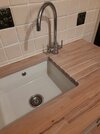I can see at least three problems here.
Firstly, that type of tap is seemingly designed to spread water onto worktops (a personal peeve of mine). Secondly, your worktop looks as though it has never been oiled, or at least it hasn't been oiled for a very long time - they need to be oiled at least once a year, often more frequently. And thirdly, if you are getting mould you are allowing the worktop to get wet and stay wet - wooden worktops always need to be wiped dry of spills and splashes fairly promptly
.
So what to do about it? Solid wood is far from ideal as a substrate for tiles because it has a tendency to move -expand and contract across the grain with changes in atmospheric humidity. Tiles applied directly onto that would potentially just pop off. You might be able to apply a single rip of cement board to the worktop, but I'm unsure how you'd deal with the edges
Sorting out the timber is fairly straightforward. You will need to get that tap off first, though (it can go back on when you are finished). The timber will need to be thoroughly dried out and the staining treated with a solution of oxallic acid crystals diluted in water. This should also clear the mould out of the timber, but may take several applications. Next the timber should be sanded, including the draining board grooves, and if the colour is too light you may want to tone it in by applying one or more coats of dilute water stain, building up to the desired tone gradually. Once dry, sand again, be as the stain will raise the grain. After doing this I suggest you treat the top surface of the wTorktop with a thin coat of wood hardener. Once that is dry the worktop can be sanded again and and then the first of three or four coats of worktop oil applied (put on a small amount, rub in, mop up and remove the excess, do another bit and so on). Because the front and rear sections of the worktop appears to be separate pieces you may need to caulk those joints with clear silicone
Solid wood worktops are a high maimtenance option and require the input of some effort to keep them functional




